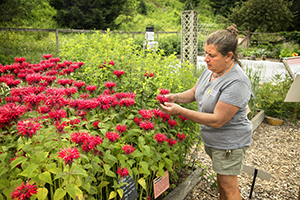Gardening in a Changing Climate
 The rising level of greenhouse gases is warming the earth’s temperature, creating change in our environments. Specifically, in the Finger Lakes region, climate change has resulted in warmer winters, summer droughts, extreme weather events, longer growing seasons, and variable temperatures. All of these related effects change the way plants grow, says Donna Levy, environmental educator responsible for our Climate Change Garden. Levy recently presented “Gardening in a Changing Climate” to Master Gardeners and shared these insights on how gardeners can adapt their gardening to respond to changing environmental conditions.
The rising level of greenhouse gases is warming the earth’s temperature, creating change in our environments. Specifically, in the Finger Lakes region, climate change has resulted in warmer winters, summer droughts, extreme weather events, longer growing seasons, and variable temperatures. All of these related effects change the way plants grow, says Donna Levy, environmental educator responsible for our Climate Change Garden. Levy recently presented “Gardening in a Changing Climate” to Master Gardeners and shared these insights on how gardeners can adapt their gardening to respond to changing environmental conditions.Plant Selection
Strategically choosing plants to put in your garden can help address changing conditions due to climate change. Trying new plants from warmer hardiness zones, growing several varieties of a vegetables that range in days to maturity, choosing more drought-resistant plants, as well as those that tolerate standing water, are some of the ways to ensure that your garden thrives.
Diversifying and choosing your plants wisely is also a great way to attract pollinators and beneficial insects that keep pests under control.
Cultural practices
Healthy, well-drained soil is key to battling droughts and extreme events. Adding organic matter to soil should always be considered. This can be achieved by incorporating organic materials, such as manure, into the soil or growing cover crops or green manures.
During summer droughts, proper watering techniques and retaining soil moisture are critical. Constructing rain barrels, watering during the cool part of the day to avoid evaporation, and using drip irrigation are ways to conserve water.
Organic mulches such as straw will not only control weeds, but also moderate soil temperatures, retain much needed water, and will in time, breakdown and add important organic matter to the soil, which is the foundation to successful gardens.
Design or Redesign
Can you build a rain garden or a bioswale? Can you add some shade to an area of high water intensity and design an outdoor living space? Layer your garden; use vertical space.
Reduce your Carbon Footprint
Some things you can do:
• plant trees
• change your mowing patterns or schedules
• recycle, reduce, and reuse your gardening materials
• teach others to do the same
More resources on gardening in a changing climate can be found on Cornell Botanic Garden’s website. Learn more about the Climate Change Demonstration Garden online or visit in person. The garden is located across the street from the Nevin Welcome Center. The garden demonstrates how a variety of plants are effected by projected temperatures in 2050.



